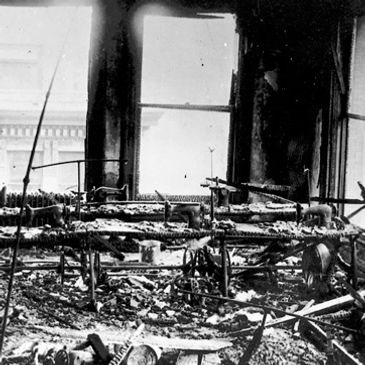The Triangle Shirtwaist Factory Fire



A Blueprint for Disaster
Shortly before 4:45 p.m. on March 25, 1911, a bin of rags went up in flames on the eighth floor of the Triangle Shirtwaist Factory. In the eighteen minutes it took for the spreading fire to consume the three floors of the factory, 146 lives were lost.
Located near Washington Square on the eighth, ninth, and tenth floors of the ten-story Asch Building, the Triangle Shirtwaist Factory was the largest maker of the popular blouses in New York City. Employing more than 600 people, it was a notorious sweatshop where workers – mostly young Jewish and Italian women new to America – toiled twelve hours a day for low wages in what would become a fire trap.
Surrounded by scraps of cloth, puddles of oil from leaking machines, and paper patterns hanging from lines strung above their heads, the Triangle seamstresses worked crowded into long rows of sewing machines separated by narrow and cluttered aisles. To leave the building, they had to go down a long, narrow hallway to reach the freight elevator, the only lift to which they had access. The factory had two staircases, but to prevent stealing, factory owners, Max Blanck and Issac Harris, locked the entrance to one from the outside, and the other door opened inward. There were no sprinklers and the building had only one fire escape, narrow and flimsy.
When the fire broke out on the eighth floor, a manager’s attempt to extinguish it was futile; the only hose on the floor was rotted, its valve rusted shut. The floor’s half-full buckets of water were equally as ineffective and the fire quickly fed off of the oil and scraps of material littering the floor, spreading to the ninth and tenth floors. Panicked and unable to reach the elevator, workers threw themselves down the shaft in an attempt to flee the flames. Others scrambled onto the fire escape only to fall to their deaths when it twisted and pulled away from the building. Fifty young men and women chose to jump from the windows rather than die in the fire.
On the ground, firefighters discovered that their pumpers and ladders did not reach the upper floors of the Asch Building. As jumping workers plummeted to the ground, the police began the grim task of identifying their broken bodies.
The aftermath of the Triangle tragedy was far-reaching. Public outrage over the fire led to the creation of the Factory Investigation Committee, which launched an examination into the safety and working conditions in New York factories. From 1911 to 1914, thirty-six new laws reforming the New York state labor code were passed. The Bureau of Fire Protection was formed to implement and enforce stricter workplace safety regulations. The administration of Franklin D. Roosevelt enacted federal reforms to ensure workers’ safety.

Click image for the names and ages of those who perished in the fire.